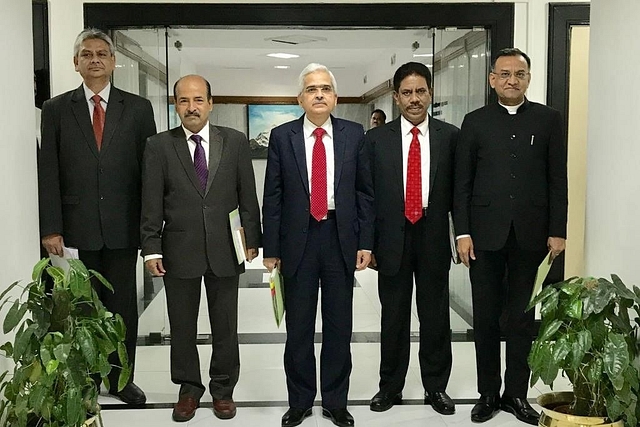
MPC’s Status Quo On Rates Is Disappointing; Here’s Why It Is Wrong
It is evident that the MPC has taken a decision that is inexplicable.
The press conference followed by the decision has only raised more concerns with respect to what is going on with India’s monetary policy.
This explainer is just to put things in context for readers to evaluate for themselves whether the decision taken by the MPC is correct or not.
The MPC (Monetary Policy Committee of India) today decided to maintain a status quo as far as the rate cuts are concerned. The argument for this was primarily driven by a wait-and-watch approach as inflation seems to have increased over the last couple of months.
This has been done at a time when the RBI (Reserve Bank of India) slashed growth forecast by another 100 basis points, which suggests that the output gap is likely to be persistently negative throughout the current financial year.
But before we discuss why the MPC is incorrect, a refresher on monetary policy. The purpose of monetary policy has been price stability and supporting growth as and when needed.
In India, however, our monetary policy framework has unfortunately stressed only on the need to ensure that inflation remains within the target of 2-6 per cent with 4 as the de-facto median of the range.
The Taylor rule captures the conduct of monetary policy in a simple framework. That is, when inflation is higher than target then increase interest rates but when it is below the target then cut interest rates.
On the other hand, if growth is higher than the potential rate of growth then increase interest rates and if it is below the potential then cut interest rates.
Interestingly, India at present has a growth rate below the potential and inflation rate below the target – which is why rate cuts were warranted. But so far, we’ve got only modest rate cuts from the MPC.
The expectation was for another rate cut; however, the MPC disappointed by maintaining a status quo.
Here’s why the MPC is wrong-
1) Inflation: The MPC has increased the inflation forecast for the rest of the financial year and it has adopted a wait and watch approach. It hinted at future rate cuts but for now has decided against a rate cut in December.
Here’s the problem: even with the current inflation forecast at 5.1 per cent, we’re well below the 6 per cent ceiling for inflation targeting. Therefore, at a time when growth is low, the MPC could have been more accommodative.
Moreover, if one looks at non-food WPI (wholesale price index) or even CPI (consumer price index) we find that the inflation level is rather muted as the recent spike in inflation was primarily driven by food prices.
Therefore, to keep rates unchanged will not really help but it will only cause more damage to the economy.
The RBI Governor had indicated that he was willing to do whatever it takes but with today’s status quo, he’s dented his credibility and it is difficult to rationally explain the decisions of the MPC.
2) Transmission: The other convenient argument against rate cuts is of transmission. That is, let the previous rate cuts be reflected in lending rates and then we will cut interest rates.
However, in the past, especially in 2008, the RBI had front-loaded rate cuts to ensure immediate signal to markets with regards to its accommodative stance. A transmission lag only justifies big and deep rate cuts that are front-loaded – rather than justifying a wait and watch approach.
Financial markets, economic growth and banking sector are indeed complex and therefore, one has to take necessary measures in time to ensure systemic stability and revival of growth rates in a time-bound manner.
By not cutting interest rates, the MPC has sent mixed signals – especially at a time when the G-sec (government securities)10-year yield is at 6.5 per cent while the Q1 nominal growth is at 6.1 per cent.
That is, revenue growth is slower than the interest burden on fresh government borrowings. Clearly this anomaly should have forced for a deeper rate cut.
3) Growth and Output Gap: As stated earlier, the RBI revised its forecast from 6.1 per cent to 5 per cent for the financial year. Therefore, it is evident that we’re looking at a negative output gap.
However, while the RBI has recognized this gap, the MPC hasn’t acted enough in order to have a truly accommodative stance.
I’ve been asking consistently for the last few months: what does the MPC mean when it says it is accommodative; mostly because our real interest rates have been high for a prolonged period.
Gradually, others are coming around and asking similar set of questions especially after today’s policy fiasco.
It is evident that the MPC has taken a decision that is inexplicable.
The press conference followed by the decision has only raised more concerns with respect to what is going on with India’s monetary policy.
This explainer is just to put things in context for readers to evaluate for themselves whether the decision taken by the MPC is correct or not.
Consider this: in 2008, in nine months the RBI cut interest rates by 425 basis points at a time when both growth and inflation were higher.
Today both growth and inflation are lower and still, we’ve just seen a rate cut of 135 basis point at a time when we’ve had some of the highest real interest rates in the world!